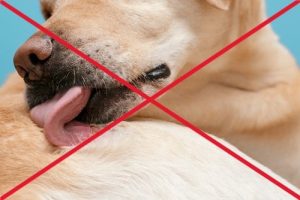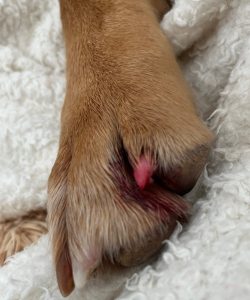Wounds in dogs
What to do
Causes
When to worry
Prevention
Diagnosis
Home treatment
Vet treatment
Risk
Wounds in dogs
Wounds in dogs are very common and can come in all shapes and sizes.
Uncomplicated cuts and grazes that are small and shallow can often be treated at home. Deep or bite wounds may need medication or surgery if they are serious or if there is a risk of infection.
These types of wounds need to be seen immediately by a veterinarian
Snake bites
Burns
Deep wounds and wounds where the bone is visible
Wounds that involve the abdominal or chest cavity
Wounds that have a lot of bleeding or bleeding that is not stopping within 10 minutes
Wounds that involve the eye
The mouths of dogs are full of bacteria - up to 600 different types. It is important to stop your pet from licking wounds. Infection can occur as a result of licking, biting, or scratching at the wound.

What to do if your dog has a wound
Serious wounds
Try to keep them calm and still, and get them seen by a local vet as soon as possible.
For heavily bleeding wounds, apply firm pressure to the area where the blood is coming from.
For burns, wash any chemicals off and rinse the area with cool, not ice-cold, water.
Be careful! Pain or distress may cause them to bite or scratch.
Other wounds such as lacerations, grazes, cuts, bite injuries, and torn nails
If bleeding, apply gentle pressure to the area with a clean cloth for up to 10 minutes.
If possible, clean the area with saline (1 tsp salt in 500ml cooled boiled water). Remove any small foreign objects that you can see.
Prevent your dog from licking, biting, or scratching the affected area.
Get the wound checked by a veterinarian to assess if the wound needs any further treatment.
Most common causes of wounds in dogs
Bite wounds
Caused by bites from other dogs or cats. Can be small puncture wounds or larger lacerations. Dog bite wounds can often be much worse than they appear due to deeper damage.
-
Cat bite abscesses usually appear 2-3 days after a bite injury from a cat. Start as a swelling but often rupture and release a pus discharge.

Dog bite wounds can range from mild to severe. The damage may be much deeper than it appears.
Torn Nails
-
Often caused by damage when running or playing. Can also be caused by cutting the nail too short.

Torn nail in a dog
Cuts, Tears and Grazes
Cuts, tears or lacerations often occur as a result of trauma from sharp objects such glass, dog bites, barbed wire, or sticks.
-
Grazes are also known as abrasions or scrapes. Only the top layer of the skin is damaged. These often occur due to contact with a rough surface or self-trauma.

Graze wound on nose
Pressure Wounds
Pressure sores are caused by increased pressure on one area of the skin over a long period, such as when a pet is lying in one place and not moving. So they are more common in dogs that are older, obese, or paralyzed.
They can also develop from bandages that are too tight or loose.
-
Pressure wounds can be difficult to treat and healing can take a long time.

Pressure wound in a dog
When should I worry about my dog's wound?
Seek help from a vet immediately if:
The wound involves the chest or abdominal cavities.
You suspect your dog has been bitten by a snake.
There is excessive bleeding or a small amount of bleeding that is not stopping.
Your dog has a deep wound, especially if there is bone visible.
Your dog's eye has been damaged.
Your dog’s wound is infected.
Joii can help if:
Your dog has a minor cut, scratch, or graze.
Your dog has been bitten by another animal, and you are not sure what to do.
You need advice about keeping your dog mentally stimulated during rest periods.
You require assistance with your dog's nutrition and weight.
Wounds can be painful, find out more about Pain in dogs
Prevention of wounds in dogs
Unfortunately, most wounds are unpreventable. Pressure wounds can be prevented by:
Do not apply bandages at home. Wrongly placed bandages and incorrect pressure can lead to new wounds.
Make sure to move your dog into different positions, if they are unwell and resting more than normal.
Use soft bedding and keep the skin clean and dry at all times.
Keep your dog in a healthy body condition and feed a balanced diet.
Diagnosis of wounds in dogs
Wounds from trauma, such as bites or scratches, won’t need any further diagnosis.
If the wound is severe, does not heal as expected, or shows signs of infection, your veterinarian may recommend additional testing, such as:
Swabbing of the wound for culture and sensitivity
Skin biopsy
Blood and urine tests
X-rays or more advanced imaging
Infection is a common problem with all wounds and can cause a delay in healing in dogs.
Signs of infection include swelling, discharge, redness, and a bad smell. Licking, biting, or scratching at the wound can lead to infection.

Blackened tissue is a serious sign of concern. Get this checked with your local vet as soon as possible. Other factors that can lead to a delayed healing time include:
Anaemia, as well as other underlying medical conditions like diabetes or kidney disease. Read more about these conditions; Chronic kidney disease in dogs
Obesity or poor diet
Certain medications: Corticosteroids, radiation therapy and inappropriate use of antiseptics
Environment: cold weather can delay wound healing, as can low oxygen levels. This includes bandages that are too tight.
Like humans, pets can also get MRSA and MRSP, though this is not common. These are antibiotic-resistant ‘superbugs’- Methicillin-resistant Staphylococcus Aureus and Methicillin Resistant Staphylococcus Pseudintermedius.
How to treat your dog’s wounds at home
With any type of wound, we recommend getting it checked with a vet in person if the wound is large or deep. If the wound is small and shallow, a video call with a vet is another option. Some wounds may be able to be treated at home. These are the most important things to consider:
Keep the wound clean and dry at all times: To keep the wound clean, use saline (1 teaspoon salt in 500ml cooled, boiled water). This can be done 1-2 times daily for the first few days.
Prevent licking, biting, scratching, and other self-trauma of the wound. Use a buster collar, inflatable collar, medical pet shirt or baby grow, socks or boots. Bitter apple spray can be used as a deterrent on top of a bandage
Restrict exercise until the wound has healed over.
Use of topical treatments to help with healing, such as manuka honey or antibacterial wound creams.
What to expect with wound healing
Most wounds heal in 3 main phases:
Inflammation and debridement: Wounds may develop mild swelling. The body gets rid of dead cells and other debris.
Repair: The tissue closes over any gaps of raw skin.
Maturation: The fibres rearrange to strengthen the tissue. This stage can last months.
Time for wound healing can vary depending on different factors, but in general, we would expect most simple wounds with no infection to heal within 5–14 days.
Vet treatment for wounds in dogs
Treatment depends on the cause, size, location, and depth of the wound. Mild wounds may require:
Shaving of the surrounding hair
Thorough cleaning of the affected area
Removal of any foreign material
Trimming back nail if broken or cracked
Bandaging
Topical creams or gels
Antibiotics or pain relief
More serious wounds may require:
First aid to stop the bleeding. Stabilisation of any other serious problems such as heart, lung, or other organ damage.
Surgery including stitches, staples, lancing of abscess and removing any foreign material, removal of dead tissue, drains, flaps, and grafts.
Laser Therapy
Management of any other condition associated with the wound, such as antivenom for snake bites or fracture repair.
Long-term care using bandages and medications.
Are some dogs at greater risk of getting wounds than others?
All dogs are at risk of developing wounds.
Cuts, grazes, and tears are more common in young, active dogs.
Pressure wounds are more common in older, obese, and inactive pets.

















